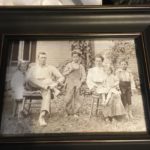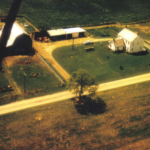By Robin Mayes, Farm Educator

We live in a time when we can snap a picture or even a video of anyone or anything at almost any time! Obviously, it has not always been this simple to capture a memory for posterity. It is certainly much easier today to record memories then when it required charcoal or a sharp tool to inscribe images on a slab of wood or rock.
For centuries, the more affluent could pay a portraitist to capture likenesses of their loved ones in ink or oil paints. Eventually, it was discovered that the blurry images created by the ancient “camera obscura”, or pinpoint camera, could be captured on a plate treated with chemicals. People often wonder why no one smiled in the old black and white portraits. Part of the reason was that it took 15 to 20 minutes of posing before the picture would develop. It was not easy to maintain a smile for that long.
When emulsion plates, or ambrotypes and tintypes became available, they took only a few seconds of exposure to capture a photo. This advancement in photography gave us the opportunity to see the faces of those young men who went off to fight in the Civil War.
Photography remained a costly endeavor and was reserved mostly for the wealthy until professional portrait studios popped up in most cities. In the late 1800’s and early part of the 20th Century, photographers traveled the countryside taking pictures of farm families. They posed in front of the house … often WITH their livestock and pets! In 1925, the first photo booth was set up on Broadway, allowing people to pop inside and get a picture for just pennies. Then the “paper moon” photo ‘opps’ of the time became popular. They were set up at every carnival and circus, and even in downtown storefronts.

By the 1940’s, cameras were more affordable and became more user-friendly. My dad even had a camera while he was overseas serving in the Air Force and brought home unique photos he took from the air and developed himself. Following WWII, some enterprising returning pilots combined photography with their flying skills and took aerial photos of farms. They flew around the countryside, taking pictures of well-kept farmsteads. Once the photos were developed, enlarged and framed, they set out on a road trip, stopping at each farm to unveil the ready-to-hang colorized photo. The proud farmer almost always bought it. My dad did, even though he had taken his own photos of the farm from the air! Today, one can take their own aerial photos with a drone!
During most of my childhood, slides were the thing. It was cool, but to see them required a lot of effort to set up the screen and projector in a darkened room or you were forced to view them in a small hand-held plastic light-up viewer. We spent an awful lot of time sitting through less-than-exciting family vacation slide shows in the living rooms of friends and neighbors!
In the 1970’s, Dad bought a Polaroid Land Camera. Wow that was exciting! You could watch the picture develop before your eyes. It was a fascinating gimmick but the film was pricey and so you didn’t shoot very many everyday occurrences. The photos also faded over time. Most farmers, being the frugal, no-nonsense people, they have always been, rarely took a lot of candid photos of their own. Cameras, film and developing the photos were expenses they did not see as necessary.
During the Great Depression, part of FDR’s ABC’s of the New Deal programs included the FSA, the Farm Security Administration. The FSA is famous for its photography activities. It put talented photographers like Dorothea Lange to work traveling the country, documenting the conditions on farms and in small towns. It was active from 1935-1944. The Library of Congress holds those photos and they can be seen on the website. They provide a glimpse into the depression.
Come to Gallant Farm in January and February and see some of those FSA images, as well as photos from Delaware County family farms, as well. If you have any vintage pictures from your family farm, we would love to display them too! Check out the collection of vintage cameras on display, as well.
We may have come a long way in communicating and recording history today. We can share our photos with family, friends and even strangers within seconds, but are we creating hard copies of them so that we can preserve them for the future even when current technology becomes obsolete?








